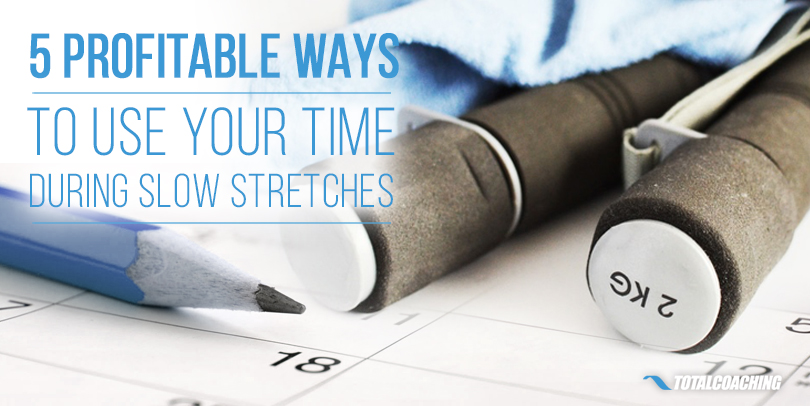Let's face it; the fitness industry is always going to be a seasonal one.
The New Year's resolution crowd will create a rush in January. There will be another bump in the springtime as people get ready to look their best during beach season. Next, your business will likely thrive in September when people look to get back into healthy routines after the busyness of summer.
But what about the rest of the year?

When business is slow, it’s easy to get bummed out: What could I be doing better? What do I do with my time now? Why do I not have any clients? Being a trainer is challenging and exciting in that way; it’s almost like we have built-in time for professional development, which is critical in our field.
Instead of wallowing when your client roster is low, take advantage of the extra time you have. Use these ideas to have fun, make more money (now and in the future), and prep for your next busy season.
1. Write Blog Posts (LOTS of them!)
Between my full-time job, freelance writing, and personal training, it feels nearly impossible to get blog posts written for my own website. Often the most important things also seem the least urgent in the moment.
Blog posts are a great way to build your website’s SEO (so you’ll show up in Google more), drive leads and attract more customers, making them an important part of your marketing plan.
Use your downtime to write, write and write some more.
Give yourself a goal like, 'I will write one blog post a week,' and stick to it. Remember: You don’t need to publish all of those articles right now either. If you’re using WordPress, you can add them to your queue, format and prep everything and then schedule to be published later.
2. Search For Other Income Streams
When I first started training, I was told to find other ways to use my knowledge outside of training:
One-on-one training will burn you out quickly if that’s all you’re doing. You need to use your skills in other ways.
Downtime presents you with a great opportunity to find other areas where you can use your expertise to make money. Here are a few ideas to consider looking into during your next dry spell:
Partnerships: Are there any local businesses or health professionals who might want to work together? I did group training at a local juice shop, which was fun for everyone, and it brought some publicity for both the juice shop and myself.
eBooks: If you’re a writer, put pen to paper (or your fingers to they keyboard) and write your first ebook. You can very easily sell on Amazon and a variety of other ebook outlets. I’ve done it before and the process is painless.
How to create an e-book
— TheSocialMediaBureau (@socmediabureau) August 30, 2016
~ian https://t.co/6ZhArbeVL2
Affiliate marketing: If you have a huge following on social media, reach out to businesses to see if they’d want you to promote them for a cut of the sales you drive. This is especially popular for trainers who are “Instagram famous.” Here's a guide to help get you started.
3. Take Up a New, But Valuable Hobby
Using different training types during sessions keeps clients excited and engaged. If you don’t try anything new, though, how will you ever discover new exercises and modalities to try with clients? Use the times when business is slow to focus on learning at a new gym or taking different classes.
If you’ve never tried yoga, this is a good one to start with. Not only was it found to be the fourth most popular indoor activity in 2016, but it’s also hugely popular with a wide variety of current and potential clients.
Yoga can be used during training sessions and for warm-ups and cool-downs. Practicing for a few months yourself will help you become familiar with proper form and flow.
Other hobbies that could inform new exercises and programs include rock climbing, aquatic aerobics, basketball, barre, and Zumba. You never know what elements will translate into future training plans you can use with your clients.
4. Try a New Marketing Technique
With more time on your hands, you can research and experiment with different marketing tools and techniques.
If you’re new to Instagram, get your page set up as a “Business Page” (look in your settings), and use the new insight features to see how well different posts do. When the next big training season comes around, you’ll know exactly when and what to post to drive the most engagement.
Your New Toolkit: Top Online #Marketing Tools for SMBs https://t.co/mVkwx8vZ79 pic.twitter.com/BpoEmUGjXa
— Patrice Truong (@PatriceTruong) September 19, 2016
Other marketing channels to try include Snapchat, Facebook and automated emails that are content and sales-based. Ultimately, the most important part is not what you try, but how you track your success.
Create a spreadsheet to be updated at the end of each week or month with the following data: total number of followers; total number of post likes, RTs, and shares; top engaging post for each marketing channel; total number of leads driven and where they came from. This will give you an overview of what’s working and what’s not.
5. Join a Local Fitness Group or Sports League
There are few better ways to market yourself than an organic, in-person conversation. Joining a local training group or sports league puts you in the perfect position to talk to people who care about fitness, show them how much you know and tell them about what you do and what you can offer.
To make the most of these opportunities, don’t be too “salesy.” Let the conversations happen naturally to avoid turning off any potential clients.
Don’t forget to keep business cards in your car or gym bag at all times, so when conversations do turn to training, your potential client won’t forget about you.
You can also volunteer your time to run or coach a group. I’ve personally been trying to find time in my schedule to volunteer for Girls on the Run. Not only would this, or another volunteer position, be an amazing opportunity to help others get active, but it’s a chance to connect with people within your community who might be interested in your personal training services.
Don’t stop working during your slow seasons. Take advantage of the extra hours in your day by learning something new, practicing with marketing techniques and driving more leads through your website and in-person conversations. When the busy season comes back, you’ll be glad you made the most of your slow period.




